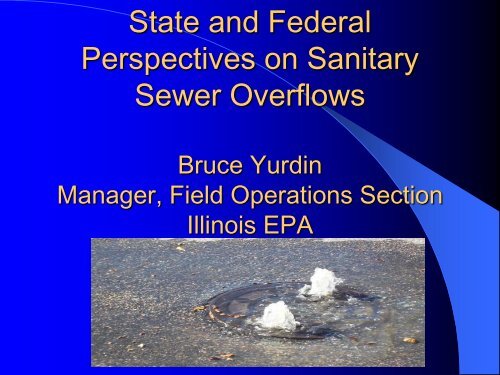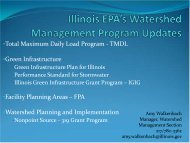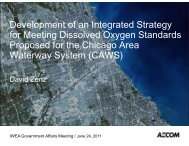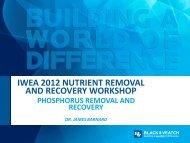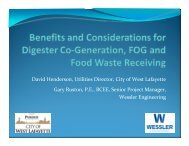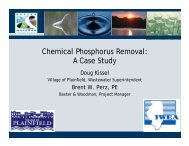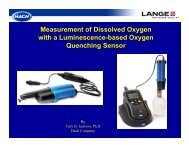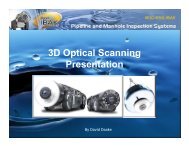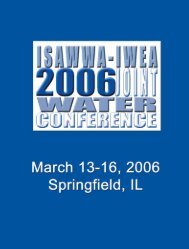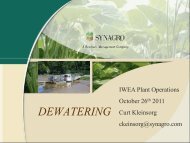State and Federal Perspectives on Sanitary Sewer Overflows
State and Federal Perspectives on Sanitary Sewer Overflows
State and Federal Perspectives on Sanitary Sewer Overflows
You also want an ePaper? Increase the reach of your titles
YUMPU automatically turns print PDFs into web optimized ePapers that Google loves.
<str<strong>on</strong>g>State</str<strong>on</strong>g> <str<strong>on</strong>g>and</str<strong>on</strong>g> <str<strong>on</strong>g>Federal</str<strong>on</strong>g><br />
<str<strong>on</strong>g>Perspectives</str<strong>on</strong>g> <strong>on</strong> <strong>Sanitary</strong><br />
<strong>Sewer</strong> <strong>Overflows</strong><br />
Bruce Yurdin<br />
Manager, Field Operati<strong>on</strong>s Secti<strong>on</strong><br />
Illinois EPA
Overview<br />
• Water Quality Improvements in Illinois<br />
• USEPA’s SSO Policy Development <str<strong>on</strong>g>and</str<strong>on</strong>g><br />
Rulemaking Efforts<br />
• Illinois EPA SSO Strategy<br />
• The Future of SSOs
Aquatic Life Use – Illinois Rivers <str<strong>on</strong>g>and</str<strong>on</strong>g> Streams<br />
1972 2010<br />
Good<br />
Fair<br />
Poor<br />
Unassessed<br />
in 2004.
What have we learned by<br />
m<strong>on</strong>itoring Illinois waters?<br />
(1972 to 2010)<br />
• Stream miles rated “good” have increased from<br />
35 to 63 percent (Aquatic Life Use)<br />
• Lake acres rated “good” or “fair” have increased<br />
from 72 to 92-100 percent (Aquatic Life or<br />
Aesthetic Uses)<br />
• The Upper Illinois River now supports walleye<br />
<str<strong>on</strong>g>and</str<strong>on</strong>g> other fishing tournaments<br />
• Unc<strong>on</strong>trolled industrial polluti<strong>on</strong> has been<br />
virtually eliminated
What have we learned…..<br />
(c<strong>on</strong>tinued)<br />
• Over $8 billi<strong>on</strong> has been invested in sewage<br />
systems <str<strong>on</strong>g>and</str<strong>on</strong>g> treatment works<br />
• Effluent toxicity at permitted facilities has been<br />
virtually eliminated<br />
• Water resource assessments have exp<str<strong>on</strong>g>and</str<strong>on</strong>g>ed<br />
• Assessment capabilities <str<strong>on</strong>g>and</str<strong>on</strong>g> tools have improved<br />
• Recogniti<strong>on</strong> that all waters w<strong>on</strong>’t improve with<br />
point source c<strong>on</strong>trols al<strong>on</strong>e; NPS <str<strong>on</strong>g>and</str<strong>on</strong>g> watershed<br />
management efforts are also critical
USEPA—SSO History<br />
• 1994 municipalities asked EPA to establish<br />
an SSO <str<strong>on</strong>g>Federal</str<strong>on</strong>g> Advisory Committee<br />
(FAC) of key stakeholders to make<br />
recommendati<strong>on</strong>s <strong>on</strong> how the NPDES<br />
program should address SSOs<br />
• Municipalities indicated a desire for greater<br />
nati<strong>on</strong>al clarity, c<strong>on</strong>sistency in NPDES<br />
requirements applicable to SSOs, <str<strong>on</strong>g>and</str<strong>on</strong>g> a<br />
workable regulatory framework
USEPA—SSO History<br />
• 1995: EPA chartered an Urban Wet<br />
Weather Flows FAC with stakeholder<br />
representati<strong>on</strong> to address crosscutting issues<br />
associated with wet weather discharges (i.e.,<br />
CSOs, SSOs, <str<strong>on</strong>g>and</str<strong>on</strong>g> storm water)<br />
• The Urban Wet Weather Flows FAC<br />
formed its SSO Subcommittee by<br />
rec<strong>on</strong>vening the SSO FAC established in<br />
1994
USEPA—SSO History<br />
• SSO Subcommittee was tasked with<br />
developing a framework for addressing<br />
SSOs <str<strong>on</strong>g>and</str<strong>on</strong>g> their impacts through regulatory<br />
<str<strong>on</strong>g>and</str<strong>on</strong>g> n<strong>on</strong>-regulatory acti<strong>on</strong>s<br />
• In January 2001, EPA prepared a notice of<br />
proposed rulemaking related to SSOs,<br />
which was withdrawn for review before it<br />
was published in the <str<strong>on</strong>g>Federal</str<strong>on</strong>g> Register.
USEPA<br />
SSO Approach 2010<br />
• USEPA Listening Sessi<strong>on</strong>s in 2010<br />
• Sought input <strong>on</strong> modificati<strong>on</strong>s to the<br />
NPDES program c<strong>on</strong>cerning SSOs <str<strong>on</strong>g>and</str<strong>on</strong>g><br />
peak flows<br />
• Five Sessi<strong>on</strong>s<br />
– June 24, Seattle<br />
– June 28, Atlanta<br />
– June 30, Kansas City<br />
– July 13, Washingt<strong>on</strong>, D.C.<br />
– July14,Webcast
USEPA<br />
SSO Approach 2010<br />
• Wastewater <strong>Sewer</strong> Types<br />
– Separate <strong>Sanitary</strong> <strong>Sewer</strong>s (wastewater <strong>on</strong>ly)<br />
• 15,800 POTWs with at least 5,000 municipal<br />
satellite collecti<strong>on</strong> systems<br />
– Combined <strong>Sewer</strong>s (stormwater <str<strong>on</strong>g>and</str<strong>on</strong>g> wastewater)<br />
• 616 POTWs (853 communities)
USEPA—Causes of SSOs<br />
from the 2010 analysis<br />
• 50% caused by blockages<br />
• 25% caused by wet weather infiltrati<strong>on</strong> <str<strong>on</strong>g>and</str<strong>on</strong>g><br />
inflow<br />
• 25% caused by mechanical/electrical<br />
failures<br />
• 23,000 –– 75,000 SSO events/year<br />
• May be similar number of basement<br />
backups/year
Annual Discharge Volume<br />
(billi<strong>on</strong> gall<strong>on</strong>s)<br />
• Treated wastewater a 11,425<br />
• CSO b 850<br />
• SSO c 3 – 10<br />
– a : EPA, 2000<br />
– b : GPRACSO model, Secti<strong>on</strong> 4.5.1 of the EPA Report<br />
to C<strong>on</strong>gress, 2004<br />
– c : Secti<strong>on</strong> 4.7.4 of the EPA Report to C<strong>on</strong>gress, 2004
Issues with NPDES Permits<br />
• No requirements to notify public of SSOs<br />
• Satellite Municipalities generally not covered<br />
• Regulati<strong>on</strong>s are unclear about reporting <str<strong>on</strong>g>and</str<strong>on</strong>g><br />
recordkeeping requirements for certain types of<br />
SSOs<br />
• Permits c<strong>on</strong>tain general requirement to ‘properly<br />
operate <str<strong>on</strong>g>and</str<strong>on</strong>g> maintain all facilities’, but does not<br />
identify specific permittee acti<strong>on</strong>s<br />
• NPDES regulati<strong>on</strong>s do not provide framework for<br />
enforcement discreti<strong>on</strong> or defense for<br />
‘unavoidable’ SSOs by the regulated entity
USEPA 2001<br />
SSO Rulemaking<br />
• Require capacity, management, <str<strong>on</strong>g>and</str<strong>on</strong>g> O&M<br />
(CMOM) program for sanitary sewers<br />
• Clarify reporting <str<strong>on</strong>g>and</str<strong>on</strong>g> recordkeeping<br />
requirements; require public notificati<strong>on</strong><br />
• Clarify SSO permit requirements to<br />
municipal satellite collecti<strong>on</strong> systems<br />
• Allowed the permittee to establish defenses<br />
under limited circumstances<br />
• Withdrawn prior to publicati<strong>on</strong>
USEPA Bypass Regulati<strong>on</strong>s<br />
40 CFR 122.41(m)<br />
• Defines bypass as “intenti<strong>on</strong>al diversi<strong>on</strong> of waste<br />
streams from any porti<strong>on</strong> of a treatment facility”<br />
• Prohibits bypass <str<strong>on</strong>g>and</str<strong>on</strong>g> allows enforcement unless:<br />
– Bypass unavoidable to prevent severe property<br />
damage, pers<strong>on</strong>al injury<br />
– There were no feasible alternatives<br />
– The NPDES authority was notified<br />
• Allows bypasses that meet permit limits if for<br />
“essential maintenance to assure efficient<br />
operati<strong>on</strong>”
USEPA’s<br />
7 Critical SSO Issues<br />
from the 2010 analysis
1. Should EPA clarify its st<str<strong>on</strong>g>and</str<strong>on</strong>g>ard permit<br />
c<strong>on</strong>diti<strong>on</strong>s for SSO reporting, recordkeeping<br />
<str<strong>on</strong>g>and</str<strong>on</strong>g> c<strong>on</strong>diti<strong>on</strong>s <str<strong>on</strong>g>and</str<strong>on</strong>g> public notificati<strong>on</strong>?<br />
• Provide notificati<strong>on</strong> to parties with a<br />
reas<strong>on</strong>able potential for exposure<br />
• Maintain an overflow resp<strong>on</strong>se plan<br />
• Provide immediate notificati<strong>on</strong> of high-risk<br />
overflows to the permitting authority, the<br />
health authority, <str<strong>on</strong>g>and</str<strong>on</strong>g> the public<br />
• Make an annual report of all overflows<br />
available to the public
2. Should EPA develop a st<str<strong>on</strong>g>and</str<strong>on</strong>g>ard permit<br />
c<strong>on</strong>diti<strong>on</strong> with requirements for CMOM<br />
programs based <strong>on</strong> asset management<br />
principles?<br />
• Properly manage, operate <str<strong>on</strong>g>and</str<strong>on</strong>g> maintain<br />
collecti<strong>on</strong> system at all times<br />
• Provide adequate capacity<br />
• Take all feasible steps to prevent SSOs<br />
• Develop Capital Improvement Programs for<br />
assets reaching the end of use<br />
• Define the level of service provided to<br />
customers
3. What are the costs <str<strong>on</strong>g>and</str<strong>on</strong>g> benefits of CMOM<br />
programs <str<strong>on</strong>g>and</str<strong>on</strong>g> asset management of sanitary<br />
sewers?<br />
• 10 years of CMOM experience<br />
– Ec<strong>on</strong>omic Analysis<br />
– Defined Health Benefits<br />
– Reducti<strong>on</strong>s in SSOs<br />
• Principles of Asset Management<br />
– Relati<strong>on</strong>ship between CMOM <str<strong>on</strong>g>and</str<strong>on</strong>g> Asset<br />
Management
4. How should EPA clarify permit<br />
coverage for municipal satellite<br />
collecti<strong>on</strong> systems?<br />
• Municipal satellite must have permit; or<br />
• Permit for Regi<strong>on</strong>al operator must require<br />
operator to implement CMOM, reporting<br />
<str<strong>on</strong>g>and</str<strong>on</strong>g> other provisi<strong>on</strong>s in satellite systems<br />
• Include satellite systems as co-permittees<br />
<str<strong>on</strong>g>and</str<strong>on</strong>g> require all co-permittees to implement<br />
CMOM provisi<strong>on</strong>s<br />
• Use a general permit for each <str<strong>on</strong>g>State</str<strong>on</strong>g>
5. What is the appropriate role of NPDES<br />
permits in addressing unauthorized SSOs that<br />
are caused by excepti<strong>on</strong>al circumstances?<br />
• SSO discharges remain prohibited<br />
• Enforcement defenses analogous to<br />
bypass/upset provisi<strong>on</strong>s<br />
– For wet weather SSOs, enforcement discreti<strong>on</strong><br />
if:<br />
• Severe natural c<strong>on</strong>diti<strong>on</strong>s, <str<strong>on</strong>g>and</str<strong>on</strong>g><br />
• No feasible alternatives<br />
• Does not c<strong>on</strong>tain advanced approval language but<br />
specific criteria (e.g. design storm) could possibly<br />
be in permit
5. (C<strong>on</strong>t.) What is the appropriate role of<br />
NPDES permits in addressing<br />
unauthorized SSOs that are caused by<br />
excepti<strong>on</strong>al circumstances?<br />
• For other SSOs, affirmative defense if<br />
notice <str<strong>on</strong>g>and</str<strong>on</strong>g>:<br />
– SSO was an excepti<strong>on</strong>, bey<strong>on</strong>d reas<strong>on</strong>able<br />
c<strong>on</strong>trol, <str<strong>on</strong>g>and</str<strong>on</strong>g><br />
– Took all reas<strong>on</strong>able steps to stop <str<strong>on</strong>g>and</str<strong>on</strong>g> mitigate
6. How should EPA address peak<br />
flow diversi<strong>on</strong>s at treatment plants?<br />
• Finalize the draft Peak Flows Policy<br />
• Incorporate the Peak Flows Policy into SSO<br />
rulemaking<br />
• Finalize draft Implementati<strong>on</strong> Guidance<br />
(including Utility Analysis Guidance)
7. How should municipalities balance all<br />
of the needs to meet water quality<br />
requirements?<br />
• How should priorities be established for all<br />
water quality needs?<br />
• What is the appropriate role of green<br />
infrastructure or n<strong>on</strong>traditi<strong>on</strong>al approaches?<br />
• What is the appropriate role of<br />
enforcement?<br />
• What is the appropriate role of permitting?
IEPA <strong>Sanitary</strong> <strong>Sewer</strong> Overflow<br />
Resp<strong>on</strong>se Guidance<br />
• Drafted July 2010<br />
• Not intended to serve as a new rulemaking<br />
or new guidance <strong>on</strong> SSOs , we intend it<br />
<strong>on</strong>ly to address our current approach <str<strong>on</strong>g>and</str<strong>on</strong>g><br />
future plans for reducing <str<strong>on</strong>g>and</str<strong>on</strong>g>, where<br />
possible, eliminating SSOs.<br />
• Recognizes it is impractical to design <str<strong>on</strong>g>and</str<strong>on</strong>g><br />
build sewer systems that will eliminate<br />
overflows under any <str<strong>on</strong>g>and</str<strong>on</strong>g> all weather<br />
c<strong>on</strong>diti<strong>on</strong>s.
IEPA <strong>Sanitary</strong> <strong>Sewer</strong> Overflow<br />
Resp<strong>on</strong>se Guidance<br />
• Illinois requirement :<br />
35 Ill. Adm. Code 306.304<br />
– “<strong>Overflows</strong> from sanitary<br />
sewers are expressly<br />
prohibited.”<br />
• NPDES permittees must notify<br />
the Illinois EPA of overflows<br />
as a c<strong>on</strong>diti<strong>on</strong> of their permit.
IEPA <strong>Sanitary</strong> <strong>Sewer</strong> Overflow<br />
Resp<strong>on</strong>se Guidance<br />
• A federal “Compliance<br />
<str<strong>on</strong>g>and</str<strong>on</strong>g> Enforcement<br />
Strategy for CSOs <str<strong>on</strong>g>and</str<strong>on</strong>g><br />
SSOs” dated April 27,<br />
2000 remains in place<br />
– basis for EPA<br />
negotiati<strong>on</strong>s with states<br />
<str<strong>on</strong>g>and</str<strong>on</strong>g> other federal acti<strong>on</strong>s
IEPA <strong>Sanitary</strong> <strong>Sewer</strong> Overflow<br />
Resp<strong>on</strong>se Guidance<br />
• EPA published a notice June 1, 2010<br />
– announced listening sessi<strong>on</strong>s in preparati<strong>on</strong> for<br />
the possible development of ???<br />
– “modificati<strong>on</strong>s to the NPDES regulati<strong>on</strong>s,<br />
including establishing st<str<strong>on</strong>g>and</str<strong>on</strong>g>ard permit<br />
c<strong>on</strong>diti<strong>on</strong>s for publicly owned treatment works<br />
(POTW) permits that specifically address<br />
sanitary sewer collecti<strong>on</strong> systems <str<strong>on</strong>g>and</str<strong>on</strong>g> SSOs,<br />
<str<strong>on</strong>g>and</str<strong>on</strong>g> clarify the regulatory framework for<br />
applying NPDES permit c<strong>on</strong>diti<strong>on</strong>s to<br />
municipal satellite collecti<strong>on</strong> systems.”
IEPA <strong>Sanitary</strong> <strong>Sewer</strong> Overflow Resp<strong>on</strong>se<br />
Guidance<br />
—Range of Opti<strong>on</strong>s—<br />
• <strong>Overflows</strong> to the ground surface<br />
– The resp<strong>on</strong>se of the sewer system owner was<br />
• timely <str<strong>on</strong>g>and</str<strong>on</strong>g> effective in correcting the overflow;<br />
• discharges were minimized when feasible by pumping or<br />
hauling sewage around the problem area;<br />
• the affected ground surface was promptly <str<strong>on</strong>g>and</str<strong>on</strong>g> effectively<br />
cleaned to minimize possible exposure to sewage;<br />
• the overflow was not a result of negligence or inadequate<br />
operati<strong>on</strong> <str<strong>on</strong>g>and</str<strong>on</strong>g> maintenance; <str<strong>on</strong>g>and</str<strong>on</strong>g>,<br />
• the sewer system owner was in compliance with NPDES<br />
permit c<strong>on</strong>diti<strong>on</strong>s regarding CMOM or similar requirements.
IEPA <strong>Sanitary</strong> <strong>Sewer</strong> Overflow<br />
Resp<strong>on</strong>se Guidance<br />
—Range of Opti<strong>on</strong>s—<br />
• Failure to properly report an SSO—NCA<br />
• Repeated occurrences of similar problems in<br />
multiple locati<strong>on</strong>s, or the same problem in a<br />
single locati<strong>on</strong>—VN<br />
• Lack of an adequate resp<strong>on</strong>se to an NCA—VN<br />
• N<strong>on</strong>-reporting of an SSO—VN
IEPA <strong>Sanitary</strong> <strong>Sewer</strong> Overflow<br />
Resp<strong>on</strong>se Guidance<br />
—Range of Opti<strong>on</strong>s—<br />
• Individual basement backups or SSOs that resulted from<br />
intense rainfall or flooding<br />
– usually were determined to warrant an NCA<br />
– usually do not result in a measurable WQ impact<br />
– SSOs resulting from extraordinary weather were felt to<br />
be somewhat bey<strong>on</strong>d the c<strong>on</strong>trol of the sewer owner<br />
– “Extreme” or “Extraordinary” :<br />
• <strong>on</strong>e-day rainfall of over 5 inches, or<br />
• flooding that results in substantial infiltrati<strong>on</strong> <str<strong>on</strong>g>and</str<strong>on</strong>g><br />
inflow into sewers in the flooded area.
IEPA <strong>Sanitary</strong> <strong>Sewer</strong> Overflow<br />
Resp<strong>on</strong>se Guidance<br />
—Range of Opti<strong>on</strong>s—<br />
• Other SSOs that result in VNs<br />
– dry weather overflows when negligence is a<br />
factor<br />
– repeated backups or overflow problems in the<br />
same area<br />
– discharges resulting from moderate or n<strong>on</strong>extreme<br />
rainfall events<br />
– inadequate operati<strong>on</strong> or maintenance
IEPA <strong>Sanitary</strong> <strong>Sewer</strong> Overflow<br />
Resp<strong>on</strong>se Guidance<br />
—Range of Opti<strong>on</strong>s—<br />
• Critical Review or Restricted Status<br />
pursuant to 35 Ill. Adm. Code 306<br />
– SSOs may indicate hydraulic capacity has been<br />
reached<br />
– additi<strong>on</strong>al c<strong>on</strong>necti<strong>on</strong>s cannot be permitted<br />
without resulting in additi<strong>on</strong>al overflows in<br />
violati<strong>on</strong> of the Act
IEPA <strong>Sanitary</strong> <strong>Sewer</strong> Overflow<br />
Resp<strong>on</strong>se Guidance<br />
—Notificati<strong>on</strong>—<br />
• NPDES Permit holders are required by<br />
St<str<strong>on</strong>g>and</str<strong>on</strong>g>ard C<strong>on</strong>diti<strong>on</strong> 12 of the permit to:<br />
– report “n<strong>on</strong>compliance which may endanger<br />
health or the envir<strong>on</strong>ment”<br />
– Verbally within 24 hours after becoming aware<br />
of the circumstances, <str<strong>on</strong>g>and</str<strong>on</strong>g><br />
– File a written report within 5 days of the<br />
n<strong>on</strong>compliance.
IEPA <strong>Sanitary</strong> <strong>Sewer</strong> Overflow<br />
Resp<strong>on</strong>se Guidance<br />
—Notificati<strong>on</strong>—<br />
• permittee<br />
• c<strong>on</strong>tact pers<strong>on</strong><br />
• locati<strong>on</strong><br />
• start time<br />
• end time<br />
• volume<br />
• cause<br />
• immediate receiving area (i.e.<br />
basement, street, ditch, l<str<strong>on</strong>g>and</str<strong>on</strong>g><br />
area, etc.)<br />
• downstream receiving waters<br />
• mitigati<strong>on</strong>/cleanup measures<br />
• planned steps to prevent<br />
recurrence <str<strong>on</strong>g>and</str<strong>on</strong>g> a schedule for<br />
implementati<strong>on</strong><br />
• identified envir<strong>on</strong>mental<br />
impacts such as fish kills,<br />
incidents of illness etc,<br />
descripti<strong>on</strong> of the comp<strong>on</strong>ent<br />
from which the release<br />
occurred)<br />
• Antecedent (72 hour) soil<br />
moisture, rainfall <str<strong>on</strong>g>and</str<strong>on</strong>g><br />
temperature c<strong>on</strong>diti<strong>on</strong>s that may<br />
have c<strong>on</strong>tributed to the SSO<br />
event
IEPA <strong>Sanitary</strong> <strong>Sewer</strong> Overflow<br />
Resp<strong>on</strong>se Guidance<br />
—Notificati<strong>on</strong>—<br />
• SSO Report Forms available at:<br />
• http://www.epa.state.il.us/water/compliance<br />
/waste-water/forms/ss-overflow2.pdf
SSO Resp<strong>on</strong>se Guidance<br />
SSO Circumstance<br />
• 1. <strong>Overflows</strong> to the ground<br />
surface<br />
a. Discharge to waters of the<br />
<str<strong>on</strong>g>State</str<strong>on</strong>g> (causes or has potential to<br />
cause violati<strong>on</strong> of WQ st<str<strong>on</strong>g>and</str<strong>on</strong>g>ards)<br />
b. Dry weather overflows<br />
c. No evidence of sewage<br />
entering waters of the <str<strong>on</strong>g>State</str<strong>on</strong>g>,<br />
owner’s resp<strong>on</strong>se timely <str<strong>on</strong>g>and</str<strong>on</strong>g><br />
effective, discharges minimized,<br />
ground surface cleaned, no<br />
negligence, <str<strong>on</strong>g>and</str<strong>on</strong>g> adequate O & M<br />
IEPA Resp<strong>on</strong>se<br />
• VN<br />
• VN<br />
• NCA
SSO Resp<strong>on</strong>se Guidance<br />
SSO Circumstance<br />
IEPA Resp<strong>on</strong>se<br />
• 2. Failure to report an<br />
overflow<br />
a. Circumstances include<br />
1.a or 1.b<br />
• VN<br />
b. Circumstances include<br />
1.c<br />
• NCA
SSO Resp<strong>on</strong>se Guidance<br />
SSO Circumstance<br />
IEPA Resp<strong>on</strong>se<br />
• 3. Repeated SSOs at <strong>on</strong>e<br />
locati<strong>on</strong>, or similar<br />
circumstances at different<br />
locati<strong>on</strong>s<br />
• VN
SSO Resp<strong>on</strong>se Guidance<br />
SSO Circumstance<br />
IEPA Resp<strong>on</strong>se<br />
4. Basement backups<br />
a. Problem with privately-owned<br />
sewer c<strong>on</strong>necti<strong>on</strong><br />
b. Problem with public sewer;<br />
owner’s resp<strong>on</strong>se timely <str<strong>on</strong>g>and</str<strong>on</strong>g><br />
effective, discharges minimized,<br />
ground surface cleaned, no<br />
negligence, <str<strong>on</strong>g>and</str<strong>on</strong>g> adequate O & M<br />
c. Recurring problem with public<br />
sewer<br />
• Technical advice to building<br />
owner or occupant; assistance in<br />
making c<strong>on</strong>tacts with municipal<br />
pers<strong>on</strong>nel<br />
• NCA<br />
• VN
SSO Resp<strong>on</strong>se Guidance<br />
SSO Circumstance<br />
IEPA Resp<strong>on</strong>se<br />
• 5. SSOs resulting from an<br />
extreme weather event<br />
• Case-by-case determinati<strong>on</strong><br />
of acti<strong>on</strong>s needed to protect<br />
human health <str<strong>on</strong>g>and</str<strong>on</strong>g> the<br />
envir<strong>on</strong>ment
Future Challenges<br />
For Water Quality Improvements<br />
• Maintain WWTP <str<strong>on</strong>g>and</str<strong>on</strong>g> PWS infrastructure<br />
• Reduce n<strong>on</strong>point polluti<strong>on</strong> from various sources<br />
• Develop <str<strong>on</strong>g>and</str<strong>on</strong>g> implement TMDLs<br />
• WW/PWS Loan <str<strong>on</strong>g>and</str<strong>on</strong>g> Secti<strong>on</strong> 319 Funding<br />
• Difficult <str<strong>on</strong>g>and</str<strong>on</strong>g> time c<strong>on</strong>suming, but we need to<br />
document water resource improvements, so….<br />
• ….we need exp<str<strong>on</strong>g>and</str<strong>on</strong>g>ed m<strong>on</strong>itoring <str<strong>on</strong>g>and</str<strong>on</strong>g> st<str<strong>on</strong>g>and</str<strong>on</strong>g>ards<br />
development programs to support decisi<strong>on</strong>s….<br />
• ….but resources are dwindling (2002-2011: IEPA<br />
down 28%, IDNR down 31%, …)
Future Challenges<br />
For SSOs<br />
• October 27, 2011, EPA Memor<str<strong>on</strong>g>and</str<strong>on</strong>g>um<br />
– Achieving Water Quality Through Integrated Municipal<br />
Stormwater <str<strong>on</strong>g>and</str<strong>on</strong>g> Wastewater Plans<br />
• EPA is developing a “Draft Framework Document”<br />
(posted <strong>on</strong> the web January 13, 2012)<br />
– “Integrated Plan” c<strong>on</strong>cept, for all CWA programs<br />
– to help EPA work with <str<strong>on</strong>g>State</str<strong>on</strong>g> <str<strong>on</strong>g>and</str<strong>on</strong>g> local governments to<br />
provide integrated soluti<strong>on</strong>s to multiple causes of water<br />
polluti<strong>on</strong><br />
• EPA will be holding five workshops in Jan.—Feb. 2012<br />
– February 17, 2012, 10:00 am to 3:00 pm at EPA Regi<strong>on</strong><br />
5 Office, 77 West Jacks<strong>on</strong> Boulevard, Chicago, IL
Future Challenges<br />
For SSOs (c<strong>on</strong>t.)<br />
• Integrated Plan should c<strong>on</strong>tain details of:<br />
– WQ, human health & regulatory issues<br />
– Existing Wastewater <str<strong>on</strong>g>and</str<strong>on</strong>g> Stormwater Systems<br />
– Community input process<br />
– Process to identify, evaluate <str<strong>on</strong>g>and</str<strong>on</strong>g> select<br />
alternatives, plus schedules<br />
– Measures of success <str<strong>on</strong>g>and</str<strong>on</strong>g> m<strong>on</strong>itoring
QUESTIONS?<br />
Bruce Yurdin<br />
Manager, Field Operati<strong>on</strong>s Secti<strong>on</strong><br />
Divisi<strong>on</strong> of Water Polluti<strong>on</strong> C<strong>on</strong>trol<br />
Illinois EPA<br />
1021 North Gr<str<strong>on</strong>g>and</str<strong>on</strong>g> Ave East<br />
Springfield, IL 62794<br />
217-782-3362bruce.yurdin@illinois.gov


